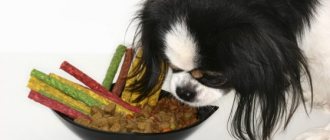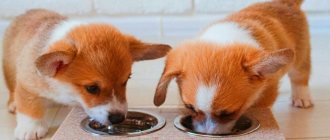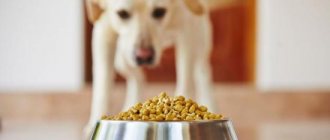Frequency of feedings per day
Puppies need a specific number of meals based on their age. The smaller the baby, the more food he needs. When the puppy is about a month old, he is allowed to feed himself, gradually moving from milk to regular food.
You can get acquainted with the approximate plan using the following table:
| Puppy age, months | Number of meals per day | Feeding schedule, hours |
| 1-2 | 5-6 | 7, 10, 13, 16, 19, 22 |
| 2-4 | 4-5 | 7, 10, 14, 18, 22 |
| 4-6 | 3-4 | 7, 12, 17, 22 |
| 6-10 | 3 | 7, 14, 21 |
| 10-12 | 2 | 7-20 |
From night until morning, the puppy should have a break in food. At this time of day, his gastrointestinal tract should not be loaded with food, so it is better not to feed the baby, even if he begins to whine and howl. And so that the pet does not cry from hunger, he needs to be given hearty milk porridge or meat at night.
Expert opinion
Anna Abramenko
An avid dog lover. Experience in veterinary medicine since 2009.
Ask a Question
If one day the owner violated the schedule and missed one feeding of the puppy, there is no need to treat him with a double portion next time.
How many times a day should you feed a two month old puppy?
Like a one-month or one-and-a-half-month-old baby, a two-month-old kitten is fed at least 5-6 times a day, with an interval of three hours. That is, the appropriate daily food intake should be divided into 5-6 equal parts, even if they seem very small to the owner. If the puppy has not finished the offered portion, the bowl is still removed in order to add the remaining food to the next portion.
For convenience, the daily amount of dry food can be weighed every morning, poured into a tightly closed container with marks on the wall. Using them, it will be much easier to navigate the required amount of food at each daily feeding and you will not have to worry about exceeding the maximum possible daily feed allowance.
Nutritional features of one-week-old puppies without a bitch
Sometimes a person has to in some way replace the mother for newborn puppies. They need to be fed every 2 hours, the temperature of the artificial mixture should be no more than +40 degrees. To do this, you will need to purchase a baby bottle with a nipple, a pipette or a syringe with a rubber nozzle.
It is better to feed one-week-old puppies with special milk powder, which can be purchased at pet stores. The composition of this food is most similar to dog milk. In addition, you can prepare a mixture at home based on goat's or cow's milk. For 1 liter you need to take 3 yolks, a pinch of salt, 2 tablespoons of liquid vitamins and a spoonful of corn oil. Mix all this and bring to a temperature of +35 degrees. and feed the baby using a bottle or syringe.
This is interesting: At what age do puppies' eyes open?
Expert opinion
Anna Abramenko
An avid dog lover. Experience in veterinary medicine since 2009.
Ask a Question
At 3 weeks, the puppy should begin to be fed with regular crushed food, monitoring the condition of the four-legged cub.
Regardless of the type of feeding, babies need water. It can be given starting from a two-week period.
Feeding
Feed the puppy at the age of 2 months so that each feeding occurs at a certain period of time. Feedings should be at least five per day. Routine at this age is important. It is necessary for the dog to eat its portion in about 15 minutes, then the bowl is removed. The next feeding occurs according to the schedule. Between feedings, you can sometimes give a vein bone or dog treat.
In order not to put too much strain on the shoulder girdle of a growing puppy, it is better to buy a bowl on a stand. Don't forget to provide your dog with access to clean water.
The menu and feeding order may look like:
- 00 - cottage cheese;
- 00 - buckwheat porridge with fish and vegetables;
- 00 - cottage cheese with oatmeal;
- 00 - porridge with meat in vegetable or meat broth;
- 00 - meat or minced meat.
It is better to hold off on dry food. It is not always possible to prepare food for your baby so often; you should try not to limit your pet to a balanced and varied diet.
If you cannot do without ready-made food, then you should buy specialized food for puppies - high-energy food for adults is not suitable for babies. They give dry food in a softened form - it can be soaked either in water or in broth until all the pieces are soaked and swollen. You need to pay attention that if the puppy is given dry food, then meat is no longer needed.
Diet depending on age
Some owners or breeders teach little pets to eat from a bowl without human assistance by 3 weeks. But most often, first feeding, and then teaching puppies to feed themselves occurs at about a month or a little earlier.
Feeding at 1 month
The basis of a pet’s diet up to one and a half months of age, regardless of breed, is mother’s milk. Therefore, the question of what to feed a small one-month-old puppy does not pose any particular difficulties. During this period, it is very important to follow a nutritional schedule. If the bitch has a large litter, but little milk, or the owner is caring for newborn dogs, then veterinarians recommend introducing early complementary foods - at approximately 2-3 weeks.
When your pet turns 1.5 months old, he will be happy to try other dairy products - low-fat kefir, sour cream, fermented baked milk, cottage cheese. For such a puppy, porridge cooked in milk is also good, which can then be cooked in meat broth.
This is interesting: Cereals approved for feeding dogs
Expert opinion
Anna Abramenko
An avid dog lover. Experience in veterinary medicine since 2009.
Ask a Question
It is important to monitor your pet’s weight gain, which will show how beneficial the chosen diet is for him.
2 months
A puppy at this age is very different from what he was just a month ago. You can already expand the menu, but at the same time you need to carefully and gradually introduce new food. It is recommended to feed your puppy dairy products for at least another 2 months. But their volume should be gradually reduced.
The table below will help you create and diversify a sample menu for a small 2-month-old puppy.
| Feeding time | Recommended Products |
| 7:00 | Cottage cheese with sour cream/oat milk porridge |
| 10:00 | Broth porridge with meat and vegetables |
| 14:00 | Milk, kefir, fermented baked milk, etc. |
| 18:00 | Porridge with meat with added butter |
| 22:00 | Raw meat or fish with vegetables |
In addition, from 1 to 3 times a week you can give a two-month-old baby boiled chicken or raw quail eggs. Fruits will also be useful for a growing body.
Expert opinion
Anna Abramenko
An avid dog lover. Experience in veterinary medicine since 2009.
Ask a Question
Meat for pets without heat treatment should be frozen for at least 3 days, and before serving it is recommended to scald it with boiling water. It is forbidden to combine this ingredient with milk in one feeding.
3 months
From three months, the puppy is transferred to four meals a day. To keep your teeth and bones strong, you should not exclude dairy products from your diet. Food should be varied and rich. If the owner previously treated the furry baby only with natural products, you cannot suddenly switch him to dry food - this will adversely affect the gastrointestinal tract.
A three-month-old puppy's teeth begin to change and his bite begins to form, so it is recommended to give him crackers and soft, non-sharp bones. Don't forget about hygiene.
Feeding from 6 months
At about six months old, small pets begin a stage of enhanced physical development. Because of this, they require much more protein food.
A significant part of the diet consists of lean meat. The puppy's menu also includes vegetables, cereals, grains, boiled or raw eggs. You can give fish a couple of times a week, but due to the low protein content, it needs to be distributed twice as much. Only marine species are suitable for this - cod, hake, pollock.
Interesting article: Which vegetables and fruits can be given to dogs and which cannot
Expert opinion
Anna Abramenko
An avid dog lover. Experience in veterinary medicine since 2009.
Ask a Question
You cannot feed your puppy minced meat. Most often, dogs simply swallow it without chewing - the pet may have problems with the gastrointestinal tract due to the accumulation of undigested residues.
Approximate diet for feeding a puppy
Let's consider the optimal diet for a two-month-old puppy. In the future, you will be able to independently adjust it taking into account the increasing needs of the body and reducing the number of feedings.
| 1st feeding | Low-fat cottage cheese or porridge cooked with milk (do not forget about regularly changing cereals. It is useful to use oatmeal, buckwheat or rice); |
| 2nd feeding | Porridge cooked in vegetable or meat broth. The addition will be meat, which can be given both boiled and raw. The optimal solution would be to choose a half-baked product; |
| 3rd feeding | Dairy products; |
| 4th feeding | You can duplicate the diet of the 2nd meal; |
| 5th feeding | Fermented milk products (cottage cheese, kefir). |
| 6th feeding | A small amount of raw meat or boiled fish. |
This is important: focus on the puppy’s needs. In some cases, you should increase the amount of fermented milk products and remove fish from the diet for 1-2 weeks. and sometimes the pet refuses meat in favor of boiled fish.
Dry food in a puppy's diet
Another food option for a growing dog is dry food. It is healthy, properly balanced, and has all the necessary substances and minerals. Such food is divided into the following categories:
- economy - the cheapest food with low energy value and a minimum of beneficial properties;
- premium - middle-priced class, the composition is significantly better than the previous one;
- superpremium - mixtures similar to natural products;
- elite (holistic) - expensive and healthy food with many additives and ingredients.
Veterinarians do not recommend economy food for puppies. Due to the lack of microelements necessary for growth and development, the pet may grow weak and often get sick.
Some tips for feeding puppies prepared food:
- Do not choose food at a low cost - the desire to save money can lead to much greater expenses for treating your pet.
- The best place to find good pet food is in veterinary pharmacies. It must be in a closed package.
- Do not forget to regularly pour clean water for drinking.
- Dry food should never be given together with natural food. When combining such products with different compositions, the functioning of the gastrointestinal tract is greatly disrupted.
- You should not often change brands of food and mix different varieties with each other in one container.
Puppies should be given finished products no earlier than 4 months. Before feeding, it is soaked in warm water half an hour before feeding.
Food options
First, you will need to decide what food to feed your dog. In Europe and the USA, numerous canned food and dry food are used; for Westerners this is commonplace. In the countries of the former USSR, dogs are fed a variety of foods, from soups to cereals. Perhaps the personal preferences of the owners, who try to feed their pets with foods similar to human ones, are to blame for creating the menu.
Often they simply do not trust dry food, considering it pampering and frivolous food. When switching to dry food, a reflex is often triggered - there is not enough food in the bowl. A larger portion is added, which seriously harms the dog’s stomach. Dry food expands, putting strong pressure on the walls of the stomach and intestines, causing pain and discomfort. Dogs are unable to stop eating food and digestive problems occur. The choice of food remains with the owner.
Natural food, however, is not always uniquely healthy and nutritious. Veterinarians are inclined to believe that soups, in addition to those with the addition of potatoes, have a serious negative impact on the health of your shaggy friend. Particularly heated debates arise when it comes to feeding dogs meat.
Most veterinarians believe that it is better to feed dogs beef, and not prime beef. Rabbit, horse meat and lamb are suitable, there is some debate about the latter, the product is fatty. The meat is given raw, after freezing the piece. There is a caution associated with the possible presence of worms in the meat.
It can be difficult to choose the type of feed. To decide which dog food is best to buy, you will need to understand the pros and cons of different types of dog food. There are different types of dog feeding: dry, wet and mixed. Which one the dog prefers is a matter of practice. The dry type of feeding has become widespread and beloved by owners of four-legged pets. However, there are many advantages and disadvantages in the mixtures.
Feeding dry food
If a breeder decides to switch a pet to dry food, a procedure for switching to this type of food and compliance with feeding characteristics is required. The dog’s stomach and digestion will not withstand the sudden transition, and the pet will begin to experience serious problems in the body. How to feed dry food to a puppy:
- Dry food is selected of high quality, premium grade. The following foods are recognized as the best dry food for puppies: Dog Chow, Pro Plan, Yakanuba, Pro Pak, Hills and others.
- If you start feeding your puppy dry food, it is better to remove other foods from the diet, otherwise mixing food will lead to indigestion.
- Dry food must be exactly appropriate for the baby’s age.
- Dry food does not replace natural nutrition; with dry feeding, the puppy is offered an additional vitamin and mineral complex.
You should switch to food gradually, over about a week.
It will be necessary to separate the food and porridge in accordance with the proportions, from a larger proportion of porridge to a larger proportion of feed. You should not overfeed your dog; it is better to give dry food in portions. There is always water next to the bowl to quench your thirst. Pet stores have a huge selection of dry food, but does your pet need formula? According to research, they are needed, but in a certain quantity. Dry food from most manufacturers contains trace minerals and vitamins. The components must be present in the animal’s body in the proper quantities, otherwise troubles with the fur are inevitable.
When choosing what to feed your dog at the pet store, pay attention to the composition of the food. The packaging requires a listing of microelements and vitamins contained in the granules. A growing body requires a lot of calcium and vitamins B and D. This is the basis for strong bones and beautiful coat. If the pet is already an adult, focus on vitamin A, E, and calcium. Metal ensures the indestructibility of the dog's health; the lack of the element is reflected in the body systems.
Dry food can cause constipation; do not put excess in your pet's bowl. The daily portion should not exceed 150 grams for a small dog such as a Pekingese or Beagle. A large dog is given up to 300 grams of food.
Advantages:
- Relatively low cost;
- Ease of use;
- Duration of storage;
- Dry food is healthier for your dog's teeth than wet food;
- There is no need to prepare your dog's food;
With the listed advantages, remember that even the best dry dog food has disadvantages: an inflated amount of preservatives and flavorings is often added to the granules; manufacturers are able to replace natural meat with low-quality waste from meat production and offal. The best dog foods are produced taking into account the needs and according to age, health status, and breed.
What is included in the feeds that confidently occupy a leading position in the ranking of quality feeds:
- Meat. The meat content in high-quality natural dog food is at least 50%. Replacing meat with offal significantly reduces the nutritional value of feed, making products cheaper. The absorption of feed, where meat is replaced with by-products or plant analogues, is significantly lower. If you decide to save on cost, you risk spending much more on treating your pet for intestinal disorders. Natural meat is considered the only truly healthy product, a source of protein.
- Vegetables. In nature, this rare predator feeds on vegetables. When kept at home, dogs do not have access to wild herbs that wild animals eat. The content of plant components in feed is elevated to the rank of mandatory. The amount of vegetables in high-quality feed does not exceed 50%. Most often, carrots and potatoes are included in the feed, and a little less often cabbage and root vegetables. Vegetables play a major role in delivering vitamins and plant fiber to the dog’s body. It is preferable for dog food to contain pieces of vegetables rather than puree or powder; when cut, plants retain more useful substances.
- Cereals. Rice, millet and oats are added to dog food. The content of cereals in the feed does not exceed 5 – 7%. Cereals are a source of plant fibers that play an important role in the dog’s digestion process and accumulate carbohydrates. Ideally, the grains are placed whole, or in extreme cases, flattened, but not in the form of a crushed substance. Manufacturers of cheap feed often purchase waste from small breweries that use broken rice. These fermented rice residues are added to the pet's food mixture.
- Fats. Fats are necessary for the absorption of a number of vitamins, and adding them to dog food is important. As a rule, animal fat is used, but to reduce the cost of feed, vegetable oils can be added. In addition, used cooking oil has an attractive odor to dogs. Feed with the addition of this oil is eaten with great appetite.
When choosing suitable food for your animal, carefully study the product packaging. In addition to the production date and expiration date, pay close attention to the composition: a true quality product contains at least 50% natural meat, pieces of vegetables, whole grains, animal or vegetable fat.
Nutrition for nursing dogs
A separate topic is worth highlighting food for nursing dogs. Food for nursing dogs is sold in pet stores. A mother dog requires a rich diet. The food contains a colossal amount of calcium, magnesium, zinc, phosphorus and vitamins necessary for the bitch and offspring.
The period of pregnancy, childbirth and lactation is severe stress for a pet. During this period, it is worth paying special attention to the pregnant dog; the dog’s health and life are under serious threat. Immediately after giving birth, a dog can go without eating or drinking for several days - the body gets rid of excess substances and experiences stress. But immediately after the wounds heal and the body recovers, the appetite will be restored and doubled.
It is estimated that a dog gives ten kilograms of milk to puppies, which requires a lot of energy to produce. For the health of puppies and mothers during lactation, vitamins and minerals are required. Remain especially attentive to chemicals; try to limit the treatment of the animal by removing antibiotics and chemical medications.
Advantages of canned food for dogs
- Separation by cost - you can choose canned goods marked premium or opt for an economical option. The first contains exclusively natural high-quality meat or fish; the economy version contains by-products and vegetable substitutes;
- Increased product digestibility;
- The quality of canned food is usually much higher than that of dry food;
Among the disadvantages of canned dog food, we note a short shelf life and inconvenience of use during transportation of the animal.
When choosing the type of feeding, take into account the dog’s age, physical activity, and time of year. You can't ignore your pet's preferences. Often the dog refuses to eat high-quality, elite food, but happily eats cheap dry food. It’s worth taking food for testing in small portions and observing the animal - whichever you like best, then decide on that.
Vitamins
As a dietary supplement, natural-fed puppies should be given vitamins for general strengthening of the body. Their norm is determined depending on age and breed. But even if the owner took a mongrel puppy, he needs useful supplements no less than a purebred representative.
Among the vitamins recommended for growing dogs, A and D are the leaders, especially in the autumn and winter seasons. They contribute to the normal development of the musculoskeletal system and the prevention of rickets.
Expert opinion
Anna Abramenko
An avid dog lover. Experience in veterinary medicine since 2009.
Ask a Question
If puppies eat dry food, they do not need extra vitamins. In this case, additional substances will only harm him.
Basic rules for feeding puppies
During the first months of life, the animal's digestive system undergoes a number of changes. This is a gradual transition to solid food, the introduction of new foods into the diet, and the colonization of the intestines with the “correct” microflora.
To make the formation process as painless as possible, experts recommend adhering to simple but effective rules:
- Bowl location . You should not feed your dog from a bowl on the floor. You should choose a food that allows the animal not to bend its back while eating. The pet's neck should be parallel to the floor when eating. This allows you to reduce unnecessary stress on the spine and contributes to the physiologically correct development of the musculoskeletal system.
- Fractional meals . The owner's desire to feed the puppy a full amount of food once a day has a detrimental effect on his health. The baby's stomach stretches, and after a short time the blood glucose level drops. The result will be a strong feeling of hunger, prompting the dog to eat in large quantities. Thus we get a vicious circle that leads to obesity.
- Even intervals between feedings . The pet has a feeling of satiety and gets used to a certain daily routine.
- Do not overfeed . Consultation with a veterinarian allows you to determine the optimal amount of food for different age groups, taking into account the breed characteristics of the pet. For a Great Dane puppy and a Pekingese puppy who is 5 months old, the amount of food will be significantly different.
- Excess feed . If after feeding your pet has a small amount of food left in the bowl, then it is recommended to reduce the next portion.
- Avoid snacking using prohibited foods (cookies, crackers, etc.).
- Do not use food from the refrigerator . Prepared food should be heated to 18-20 degrees Celsius.
- Use a variety of products , avoiding a poor and monotonous diet.
A prerequisite for proper nutrition for both a puppy and an adult dog is round-the-clock access to fresh water. In winter, it is enough to change the water once a day, and in summer it is recommended to do this twice a day. This helps avoid the development of intestinal diseases. You should also not leave food in the bowl after the puppy has left it.
You might also be interested in our article on where to start raising a puppy
Prohibited Products
Newly-made owners are often afraid to make a mistake and feed their furry baby food that is harmful to him. In addition to the fact that you should not give puppies cold and hot food, there is an important list of foods prohibited for them:
- bread, loaf, sweet pastries;
- candies, chocolate, honey, jam;
- everything that causes flatulence and bloating - cabbage, grapes, peas, beans, plums;
- pork;
- River fish;
- fried, spicy, salted, smoked;
- sausages;
- ketchup, mayonnaise, various sauces;
- bones.
?
Food from a human table is unacceptable and dangerous for puppies.
List of healthy and harmful foods
products that benefit a young body:
- Lean varieties of meat, fish and poultry;
- Meat and fish by-products;
- Fresh vegetables and fruits;
- Sour cream, kefir, cottage cheese, whey and other fermented milk products without flavoring additives and sugar;
- Porridge.
Don't be afraid of the apparent scarcity of your pet's menu. A dog by nature is a predator, so its diet consists mainly of protein foods.
Veterinarians include the following in the category of prohibited
- Candies, cookies, sweets. They contain glucose, which starts fermentation processes. For predators, they have a negative impact on the state of the digestive system;
- Spicy, salty dishes, as well as food with a lot of spices;
- Tubular bones. When chewed, they crumble into many small fragments that can cause intestinal obstruction and injury to the esophagus;
- Pork. It is a source of trichinosis, which is difficult to treat and painful for the dog;
- Whole milk. The pet's body is not able to absorb it;
- Cabbage and various types of legumes provoke fermentation processes;
- River fish, which becomes a source of helminthic infestation;
- Sausages containing a large amount of harmful impurities, dyes and preservatives.
- Boiled potatoes, which are not digestible in the puppy's digestive system.
By refusing to use harmful ingredients in your four-legged pet's diet, you will maintain his health, strengthen the immune system and raise a healthy dog.
General recommendations
Veterinarians usually emphasize how harmful overeating is for a dog. But lack of food can also cause her health problems. To avoid this, be sure to follow a few simple tips:
- The puppy should always have access to clean water at room temperature. The drinking bowl should be washed regularly.
- It is necessary to create a feeding schedule and not violate it.
- Portions should be calculated based on weight parameters.
- If your pet has eaten much less than usual, there is no need to increase the amount of food at the next feeding.
- There is no strict schedule for the diet, but you cannot replace one product with another that is unequal in composition and nutritional value - for example, put more cereals in a dish rather than meat.
- If you refuse a certain product, you should not worry or force your pet to eat - it is better to give him what he likes.
- Each meal should last no more than 15 minutes. If during this time the puppy has not eaten everything, the owner needs to put the remaining food in the refrigerator.
- Plates with food are placed so that the dog does not have to bend over to them. Otherwise, this will lead to improper formation and development of skeletal bones. An adjustable stand with a tripod will help avoid this.
- You can’t have an active pastime immediately after eating - you should wait 1-2 hours and then start walking, playing and training with your four-legged friend.
Providing proper and balanced nutrition for a growing pet is not difficult. You just need to remember which foods are recommended for the puppy and which are strictly prohibited, and also strictly follow the feeding schedule. If your four-legged friend is cheerful and cheerful, his coat is smooth, shiny, and his teeth are healthy, then all this indicates the right choice of food for his pet and the owner’s care for him.
What is the best way to feed a puppy?
Before preparing your dog’s daily diet, you need to decide what kind of food you are going to give your pet. There are only 2 options: ready-made dry food or natural food, represented by meat, grains, vegetables and fruits. Each of these cases has its own characteristics of feeding products.
Dry food
Among the dry food mixtures for dogs on the market, there are both economy-class products and more expensive premium food and holistic food. Considering the high need of a growing body for vitamins and minerals, it is better for the owner to pay attention to the latest options, which are distinguished by a higher quality composition. A veterinarian will help you decide on the brand of food, taking into account the health of the animal and its breed characteristics. If you rely only on consumer reviews, then for puppies of small breeds (for example, Yorkshire terrier or Spitz), the following products will be a good solution for regular feeding:
- Guabi Natural for puppies;
- Acana Heritage;
- Applaws with chicken.
For babies of larger breeds (Alabai or Shepherd) it is better to choose puppy food from one of the following companies:
- Acana Heritage;
- "Orijen"
- “Savarra with lamb and rice”;
- "Applaws."
If the owner does not have the opportunity to purchase dry food for puppies of a specific breed, you can always buy universal food suitable for babies of any breed. Popular products in this direction are:
- Orijen grain-free food;
- hypoallergenic composition with lamb and rice for puppies prone to allergic reactions (for example, pugs, bulldogs, Shar Peis, Pekingese);
- with salmon and turkey Carnilove;
- with potatoes and salmon Optima Nova Sensitive;
- with trout and salmon Barking Heads Puppy Days.
It is not necessary to soften dry kibble before giving it to your puppy. Two-month-old kittens can already chew them on their own, but if the baby does not like the smell or consistency of such food, at first you can soak it in warm boiled water, leaving it covered for 30–40 minutes.
Did you know? If a puppy does not interact with people in the first three months after birth, it will remain wild for the rest of its life. Scientists consider Australian dingoes to be a separate species of such feral domestic dogs.
homemade food
Homemade food may well become an alternative to complete ready-made food, but only if the dog owner can accurately calculate the volume of certain products required for puppies. A natural menu for two-month-old pets usually consists of:
- low-fat varieties of meat (chicken, beef, veal, turkey, rabbit), which, before giving it to your pet raw, must be frozen in the refrigerator for at least three days and then cut into not very small pieces;
- meat by-products (beef tripe, liver, heart and udder), the volume of which should exceed the amount of pure meat by one and a half times and be given to the dog no more than 1-2 times every 7 days;
- cereals (oatmeal, buckwheat and rice);
- dairy products (kefir, cottage cheese, yogurt), which are introduced into the puppies’ diet every other day;
- vegetables (most often small puppies and adult animals are given pumpkin crops, carrots, broccoli and cauliflower, but you should also focus on the kitten’s personal preferences.
Before giving the puppy vegetables, they are boiled or steamed, adding a small amount of vegetable oil, but in the intervals between main feedings, you can give your pet raw foods to improve the functioning of the stomach and strengthen the jaw.
Boneless sea fish scalded with boiling water, fruits, berries and eggs, boiled in the usual way or raw, will help diversify the diet of a two-month kitten. You can replace meat with fish once or twice a week, but due to its lower calorie content, it will require 2 times more than beef or rabbit meat, so owners are not always ready to change their usual regimen.
Important! Meat should not be combined with dairy products, since different intestinal enzymes are needed to digest these products.
It is advisable to give meat food to your pet in combination with vegetables, and cook porridge in water or broth, with the introduction of plant ingredients.











